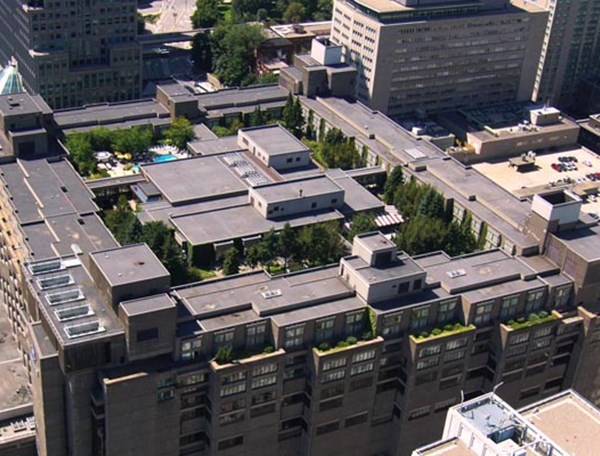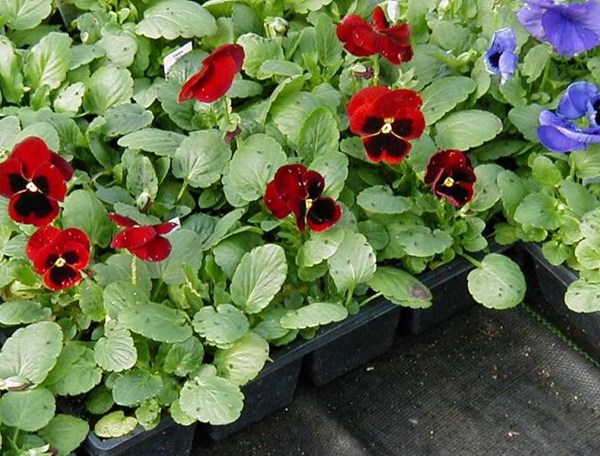Training Center
Urban Gardening - A Growing Trend
Thursday, September 7, 2023 | Susan Parent
A lot of information is circulating about construction of green roofs and rooftop gardens in many big cities in North America and Europe. City residents and businesses are looking for ways to reduce their environmental footprint and minimize smog and heat build-up during the summer. Plants can help by using up waste carbon gases in the atmosphere, a contributing factor to the greenhouse effect and various health issues (asthma, respiratory problems…etc). The construction of roof top gardens and/or urban gardens can contribute not only to alleviating poor air quality in cities, but also increase sustainability of urban areas and improve overall quality of life. A new generation of gardeners are eager to practice urban agriculture to not only clean the air, but to produce locally grown food.
What are roof top gardens and green roofs?
Both terms can be used interchangeably, but refer to everything from flower planters on a roof terrace to the roof of an industrial building covered with vegetation. Actually, roof top gardening refers to urban agriculture while green roofs are a construction technique that requires specific building characteristics.
Urban Gardening
Urban gardening is the most accessible practice for gardeners in the city; however, it doesn’t have to occur on a roof. It could be in a community garden, where residents grow their own vegetables, herbs and flowers. Access to space for traditional gardens is difficult to find, especially in densely inhabited cities. Roof tops can be used for this if the buildings meet certain construction requirements and weight restrictions. Many existing buildings are being retrofitted to support the extra weight of rooftop gardens as it is becoming a popular selling feature for both old and new construction. More information is available through local, urban garden groups or landscape architects.
Green Roof
A green roof is a layer of vegetation that is grown on a roof top. The vegetation can be very diverse. One type of green roof consists of low growing plants like, sedums, succulents and other hardy plants that can tolerate high and low temperatures, lack of water, strong winds and other stresses. Another type of green roof, which is more elaborate, consists of a garden or park on a roof top with diverse vegetation from annuals to trees and sometimes includes animals and water streams. A hotel in Montreal has this later type of green roof that covers 2.5 acres and was built back in 1967.
Green Walls
Green walls are a vertical layer of vegetation that is found either on an outside or inside wall of a building. Green walls are a good option if the roof of a building is not capable of being planted. It does require trellises or cables to keep vines or plants anchored to the green wall and they are often “subirrigated” with recirculated fertilizer solution that flows by gravity from the top to the bottom of the wall.
Roof Top Greenhouse
The last type urban agriculture production occurs in greenhouses that are built on top of flat roofs of industrial buildings. This type of construction is costly, but food chain stores, like Whole Foods, have invested in these greenhouses to produce local food to supply their stores. The advantages are that the produce doesn’t need to travel long distances, it’s locally produced and helps companies reduce their carbon footprint.
Examples of roof top gardening in different cities:
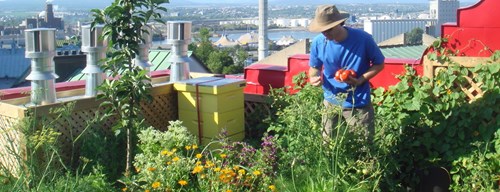
Rooftop gardening in Quebec City, QC (Picture from urbainculteurs.org)
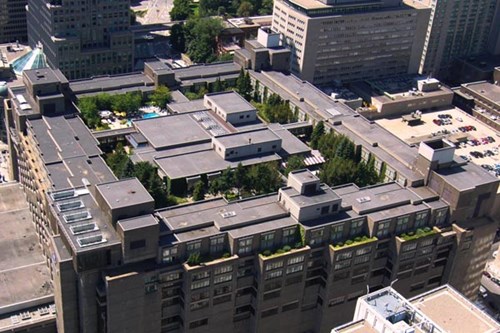
Rooftop gardening at Hilton Bonaventure in Montreal, QC
Crop production
The most common, small scale urban gardening is growing vegetables and herbs in raised beds or large containers on roof tops. Restaurants and homeowners are producing crops this way and are satisfied with the results. Growing crops on roof tops have unique challenges as environmental stress is often greater. Sunlight can be intense especially on top of high rise buildings and with the absence of trees to provide shade or cool the air, it can become excessively hot. Wind speed can be much higher on top of roofs, but wind breakers can be used to mitigate plant stress.
Other than these stresses, plants grown on roofs have the same needs as those in the ground; they need water, fertilizer and good quality soil. A water source must be provided and all runoff water is typically captured through a recirculation system. Fertilizer can be pre-incorporated into the growing medium or injected into the irrigation water either in the form of organic or synthetic water soluble fertilizer. Choosing a growing medium is often a challenge and in the next article, a review of the different types of media used for these growing methods will be presented.
Advantages of urban gardening and green roofs
Reduce heat build up in cities
In the summer, sunlight is absorbed by roofs which makes them very hot. The heat then is radiated back into the air, increasing the ambient air temperature and into the building, increasing cooling costs. Having vegetation on the roof shades the roof, reducing heat retention and the heating of the air inside and outside the building. In addition, plants cool the air through transpiration in which the sun’s heat converts free water within the leaves into vapor that passes out into the atmosphere.
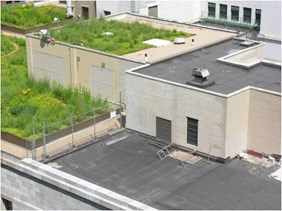
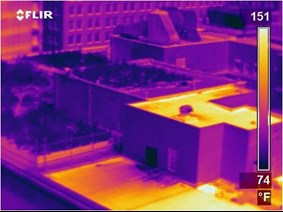
Left picture: Chicago City Hall Green Roof. Source: Chicago Climate Action Plan report.
Right picture: Infrared Image of Chicago City Hall Green Roof. Heat sensing technology (picture on right) shows on a typical day, the Chicago City Hall green roof is up to 80°F (44°C) cooler than the neighboring conventional roof. Source: Chicago Climate Action Plan report.
Locally grow
The interest in buying locally grown produce is increasing in popularity. This is sparking interest in growing new types of herbs and vegetables that are hard to find and it is providing opportunities for the horticulture industry. Products and accessories have emerged to accommodate this new generation of gardeners (i.e. smart pots, earth box, etc.).
Fresh food available all year round within a short distance
Availability of fresh produce almost all year round is a strong feature for urban developers in cities. Many grocery store chains are offering local produce to meet the demand.
Rainfall Water management
Rain water runoff is a problem in cities. Green roofs can help in reducing the runoff considerably, as the plants can use the water to support growth.
There’s a lot of interest in urban gardening for both commercial developers and a new generation of home gardeners. The excitement and interest has given journalists and garden columnists something to talk about and promotes a new image of gardening to help entice the younger generation to start their own gardens.
References:
- SPSQ, 2013 "La serriculture sur les toits en milieu urbain. Perspectives de développement dans le contexte québécois." 139 p.
- Antoine Trottier,2007 "Toitures végétales: implantation de toits verts en milieu institutionnel. Étude de cas : UQAM" 80p.
- Eva Wong et al, 2007 "Reducing Urban Heat Islands: compendium of Strategies: Green Roofs, EPA office of Atmospheric Programs." 26 p.
For more information, contact your Premier Tech Grower Services Representative:
 |
 |
 |
 |
|---|---|---|---|
|
Ed Bloodnick |
Nathan Wallace-Springer |
Lance Lawson |
Victor Brantly |
 |
 |
 |
|
|
Troy Buechel |
Susan Parent |
Jose Chen Lopez |
PRO-MIX® is a registered trademark of PREMIER HORTICULTURE Ltd.
Related Articles
-
Criteria for Growing Media for Roof Top Gardening
In this article, we will discuss the ideal growing medium and properties required for roof top gardening.
-
Influence of Watering Technique on Disease & Other Root Zone Problems
Watering techniques have a major influence on crop quality and several crop production concerns.

 Where to find our products
Where to find our products
